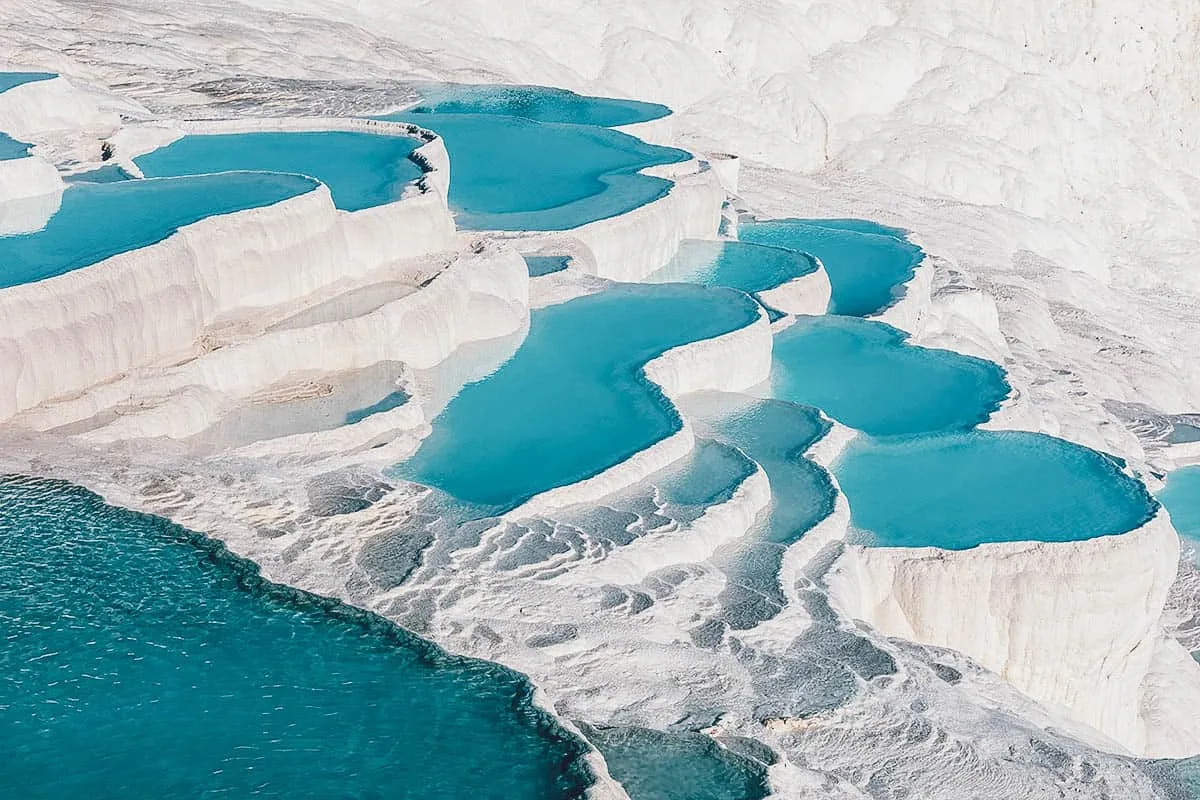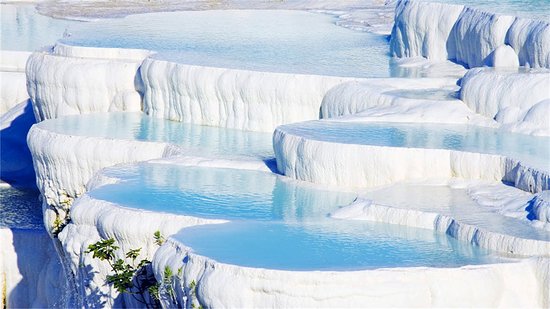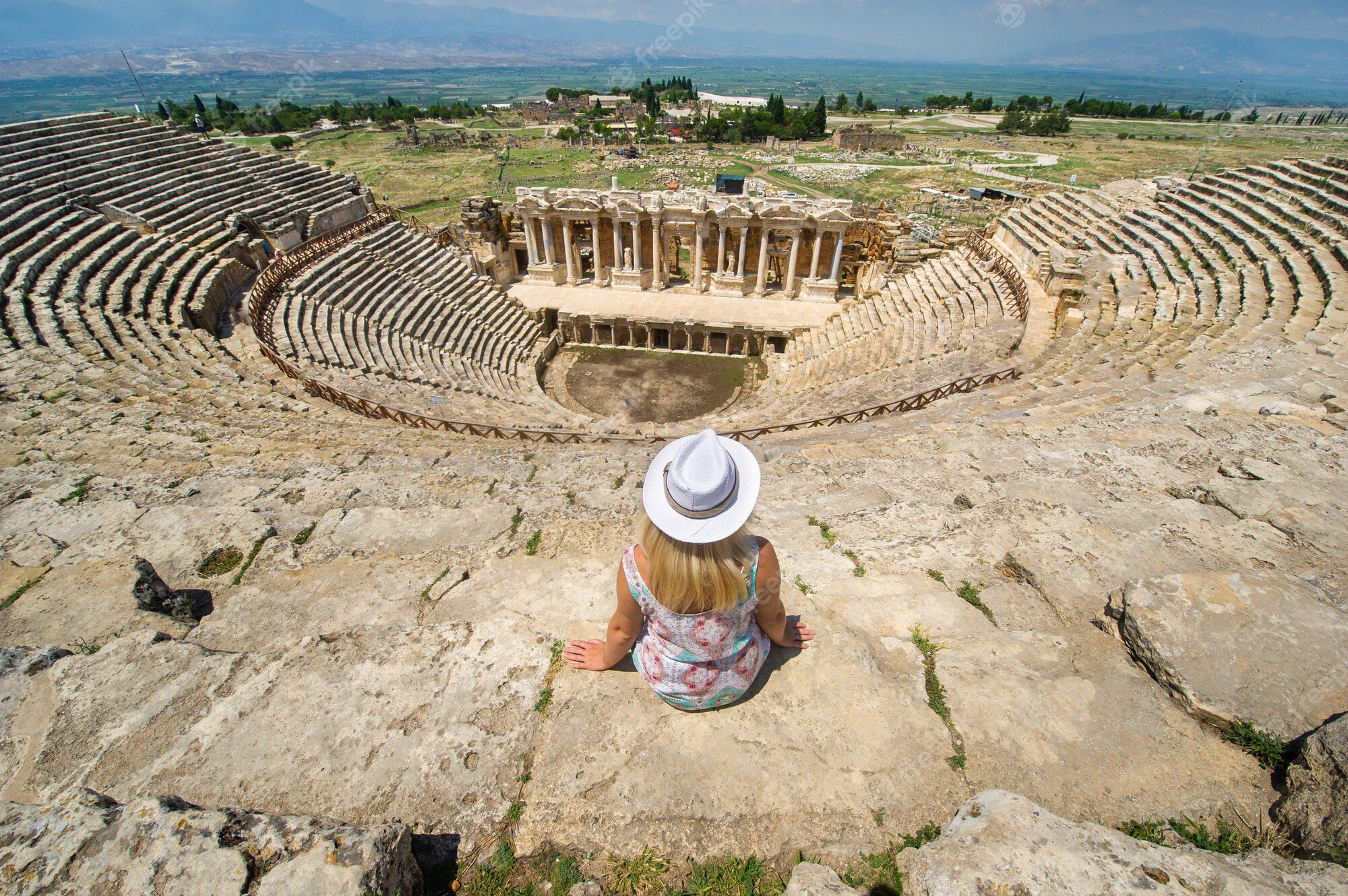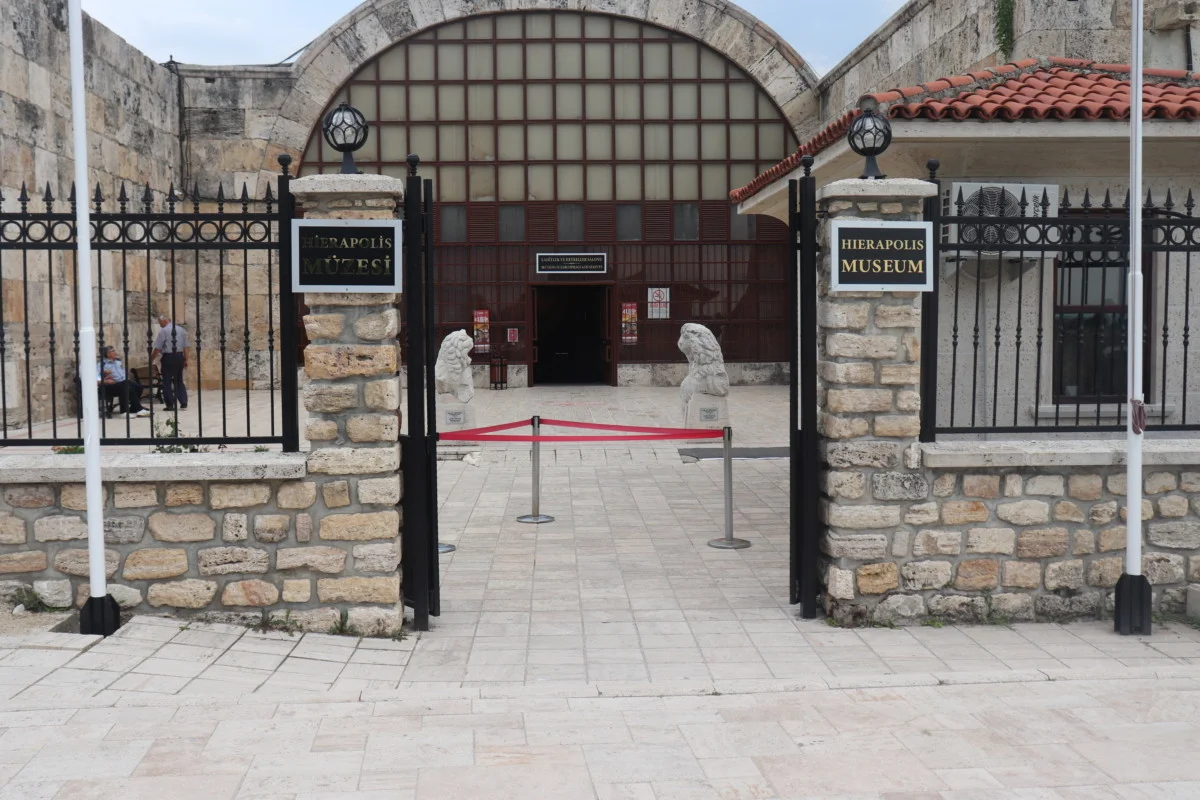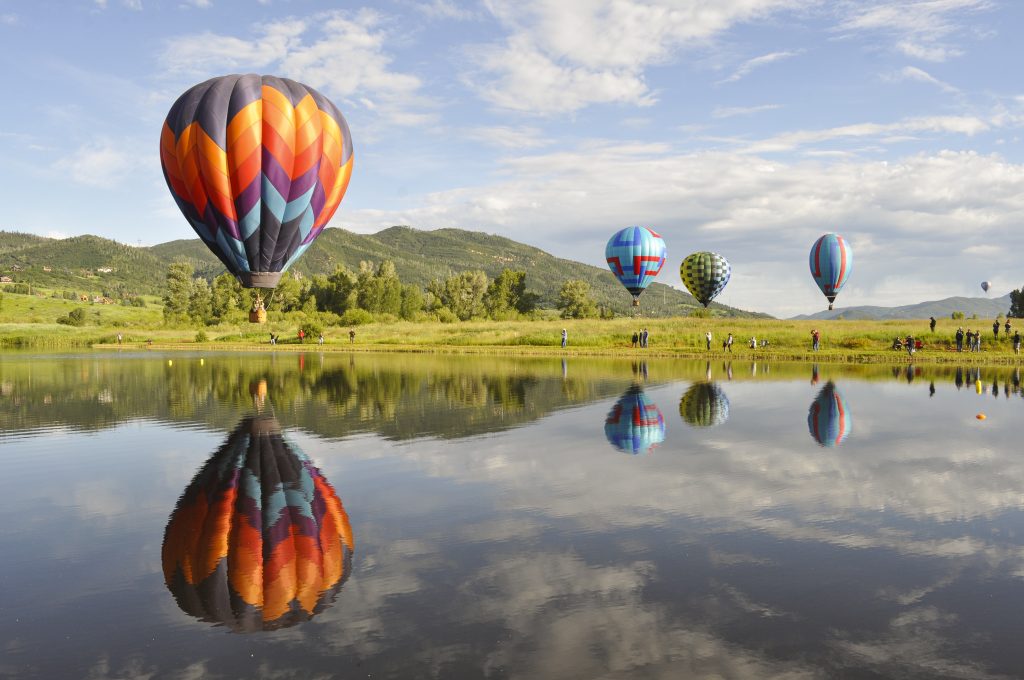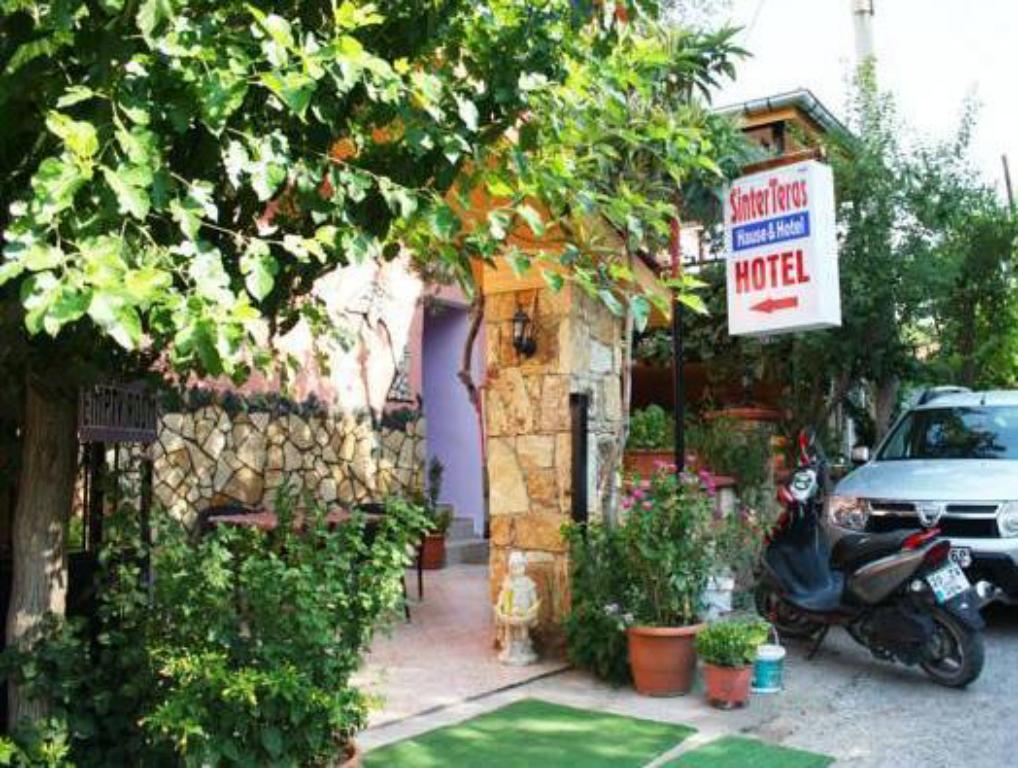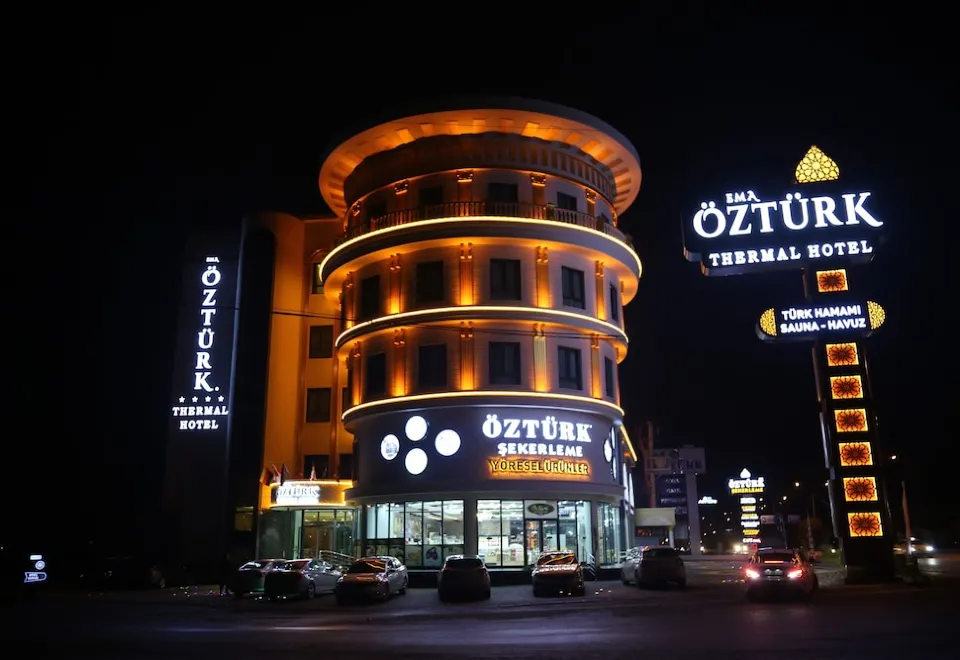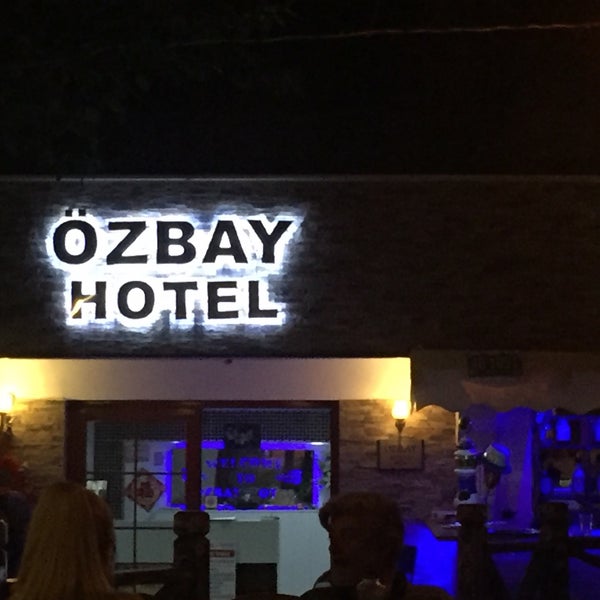- 2023
- 06
- Feb
If you're wondering how to go to Pamukkale in Turkey, here is the guide. We'll tell you everything you want to know about Pamukkale's water pools right here. From the opening hours of Pamukkale to places to stay and eat near Pamukkale. We also explain how to go to Hierapolis and where to stay in the vicinity of Pamukkale and Hierapolis.
The cotton castle. White velvet rocks. White heaven. Hot water springs are magically therapeutic. What a creative way to promote Pamukkale!
It sounds like something out of a fairy tale rather than a genuine location. Add to it a nicely photo-shopped image in the brochure, and you'll have a lot of people heading your way!
Pamukkale, which translates as "cotton castle" in Turkish, is a natural feature in Denizli Pamukkale otelleri, Turkey's southwesternmost province. The location is well-known for a carbonate mineral left by running water.
Over hundreds of years, this mineral has developed whitewater pools that are recognized all over the world for their therapeutic powers.
Pamukkale is much more than hot springs, and we'll tell you about all the fun things to do there in our guide!
WHERE IS PAMUKKALE?
Pamukkale is a small town in the Denizli Province in southeastern Turkey. It is around 19 kilometers from Denizli.
It's in Turkey's Inner Aegean area, in the River Menderes valley, and the weather is pleasant most of the year.
Turkey is a large nation, and most visitors do not make it to the Pamukkale hot springs because they are located very far from the country's capital.
WHY SHOULD YOU VISIT PAMUKKALE?
Pamukkale is worthwhile to visit for a variety of reasons. To begin with, Pamukkale is steeped in ancient history and mystery. The hot waters of Pamukkale have long been thought to have medicinal powers.
There is folklore about a little unattractive girl who lived in a small town near Pamukkale. Nobody wanted to be with her since she was so unattractive. She got desperate and lonely, and she contemplated suicide.
The hot waters of Pamukkale have long been thought to have medicinal powers. There is folklore about a little unattractive girl who lived in a small town near Pamukkale. Nobody wanted to be with her since she was so unattractive. She got desperate and lonely, and she contemplated suicide. She plunged down the tallest cascade, but instead of being crushed to death, she landed in one of the pools of water. Water's mystical powers took away her sorrows, and she transformed into a very lovely young lady. She encountered the lord of Denizli after getting out of the water, and after being charmed by her beauty, he proposed to her. They had a happy ever after.
She plunged down the tallest cascade, but instead of being crushed, she landed in one of the water pools. Water's mystical powers took away her sorrows, and she transformed into a very lovely young lady. When she emerged from the water, she encountered the lord of Denizli, who was so enamored by her beauty that he proposed to her. They had a happy ever after.
The Turks claim that taking a dip in the pools can treat ailments including eye and skin conditions, digestive and circulatory issues, nutritional and chronic disorders, etc. As a result, Pamukkale has been a thriving spa resort since ancient times. Cleopatra herself bathed in the therapeutic baths.
Apart from the medicinal powers of the water, Pamukkale's travertine pools are bordered by some stunning ruins and historical buildings.
HIERAPOLIS:
The ancient Greek city of Hierapolis, which is located above the pools, is one of these sites.
In the second century BC, Hierapolis was developed into a spa. It was transformed into a therapeutic facility, with doctors using the thermal springs to cure their patients.
A massive earthquake in 17 AD destroyed the city altogether. It was reconstructed by the Romans, who also created a large amphitheater.
Thousands of people flocked to the therapeutic water pools. The city flourished and became exceedingly prosperous. But, throughout hundreds of years, there were other earthquakes, and the city never fully recovered, finally being deserted around the 14th century.
The ancient city was rediscovered by tourists in the twentieth century (I hope we make a huge discovery like this one day), and the hot springs became famous again.
Read also Complete guide to Pamukkale hot springs
TOP THINGS TO DO IN PAMUKKALE
In and around Pamukkale, there are a lot of things to see and do. Some of the places and events you shouldn't miss are listed below:
1. TAKE A BATH IN THE TRAVERTINE POOLS
Bathing in the brilliant white travertine pools is a definite must when visiting Pamukkale. Calcium deposits from the area's hot springs formed these natural rock ponds.
These deposits formed on Pamukkale's steep slopes in the same way that stalactites grow within caves. Over time, they grew and branched out into pools.
To get to these pools, walk (barefoot to avoid damaging the travertine) from the bottom of the site to the top, where these little natural baths are located.
The pools towards the top of the site are the warmest, while those near the bottom are tepid.
2. VISIT HIERAPOLIS' RUINS
Around 190 BC, King Eumenes II of Pergamon constructed Hierapolis as a fortified Greek colony. While the city began as a military outpost, it was eventually changed into a spa resort.
The city's ruins include stunning long roadways flanked by tall columns. The Hierapolis remains beside the Antique Pool were reached after Cynthia and I ascended through the limestone slopes of Pamukkale.
We went about for hours, taking in the grandeur of the ruins. A Necropolis is located in the northern portion of the ruins, while a Byzantine church is located in the southern portion.
3. SAVOR THE VIEW FROM THE HIERAPOLIS THEATER
If you visit the Hierapolis ruins, the major attraction is the theatre. It sits on a mu\hill, overlooking the remainder of the ancient Greek settlement. It takes around ten minutes to walk from the destroyed city's entrance to the theatre.
The theatre has been meticulously maintained and retains much of its original detail. You'll have a great view of the immaculately restored stage if you sit in one of the upper seats.
4. BATHE IN PAMUKKALE'S ANTIQUE POOL NEAR APOLLO'S TEMPLE
The Apollo temple is close to a few more pools that are worth visiting. These, unlike natural travertine pools, were carved into the rock by the Romans.
It's a one-of-a-kind hot spring experience, with submerged columns and temple marble fragments sprinkled in the water. I've never had an experience like this before!
Swimming in these Roman pools costs 50 Lyra in addition to the 50 Lyra required to visit the site.
Children under the age of six can enter the vintage pool for free, while children aged six to twelve must pay 13 Turkish Lira. The pool is only available from 8 a.m. to 9 p.m. daily from April to October. While bathing in the healing waters, you can store your belongings in lockers, but towels are not provided.
5. VISIT THE HIERAPOLIS MUSEUM
This small museum, housed in a former Roman bathhouse, houses an interesting collection of Hierapolis antiquities.
It will be easier to visualize Hierapolis after visiting the museum. It displays exquisite artwork, ancient sarcophagi, and stone reliefs that the area was renowned for. Sculptures from the adjacent Aphrodisias archaeological site are also included in the entire collection of antiquities.
6. GO ON A HOT AIR BALLOON RIDE IN THE MORNING
A hot air balloon quietly gliding over the travertine swimming pools comes to mind. The views you'll get will be unique!
Not only will you receive a unique aerial perspective of the pools and the old ruined city of Hierapolis, but the breathtaking hues of the sunrise will make this an experience you will never forget!
These hot air balloon trips may be scheduled through one of the Pamukkale travel agencies or in advance online. A champagne breakfast is included in the hot air balloon tour.
CAN I GO TO PAMUKKALE SAFELY?
Pamukkale is unquestionably safe. However, I would advise caution when walking near the travertine pools because the white stones can be quite slippery.
You'll have to walk over rushing water-covered rocks, and there are sharp-edged bits of limestone in certain places. The same is true when touring the Hierapolis ruins (see above). Some of the rock blocks have become loose over time, so proceed with caution!
Don't be concerned if you want to wear a swimsuit in Pamukkale. When compared to neighboring Middle Eastern countries, Turkey remains quite liberal. Or, at least, it is in the more touristy areas of the country.
Bathing in the vintage pool in a bikini should be OK.
Another item I strongly advise is to carry a nice pair of sunglasses. If you don't shield your eyes from the glare of the white limestone during the day, it might harm them.
PAMUKKALE HOURS AND CHARGES
A Pamukkale ticket allows you to access the site for the entire day. The ticket includes admission to both the hot springs and the Hierapolis ruins. Pamukkale and Hierapolis tickets cost 60 Lyra.
In the summer, the opening hours are 06:30 to 21:00.
You might also purchase an All Turkish Museum Pass, which includes admission to Pamukkale. The pass costs 375 Lyra but is well worth it because it allows you to visit over 300 museums and archaeological sites around Turkey.
You can also skip the Pamukkale entrance line with this Turkish Museum Pass.
WHAT TIME OF YEAR IS BEST TO VISIT PAMUKKALE?
The greatest time to visit Pamukkale is in the spring. Between April and June, the weather is typically pretty pleasant, and many flowers blossom around the location.
Fall, from September to October, is also a great time to visit Pamukkale, but it can be a bit rainy at that time of year.
I wouldn't suggest going to Pamukkale in the winter because it will be quite chilly as you exit the springs, not to mention that it may snow on occasion. These are Pamukkale otel fiyatlari:
WHAT CAN YOU EXPECT FROM PAMUKKALE?
Although Pamukkale appears pristine, deserted, and breathtaking on travel bloggers' Instagram accounts, this is not the case in reality.
It will not appear precisely as in the photographs, but it will still be beautiful if you come after sunset. If you visit Pamukkale during the high season, you should also expect to see a lot of people.
The majority of international visitors will visit Pamukkale as a day excursion from Denizli. They normally come in the early afternoon via bus.
I would recommend renting a hotel in Pamukkale so you may visit the sight early in the morning before the throngs gather, as we did.
WHERE SHOULD I STAY NEAR PAMUKKALE?
While the majority of visitors choose to stay in Denizli and go to Pamukkale by bus, we believe it is preferable to book accommodations close to the hot springs. By staying at Pamukkale, you will be able to explore the site before it becomes overrun with visitors.
The following hotels are within walking distance of the travertine pools at Pamukkale:
1.The Hotel Sinter Terasse
This is our favorite Pamukkale hotel. The motel rooms were comfortable and peaceful. The unique care and attention offered by the personnel and the hotel's owner were what drew us in.
The host, Sami, is nice and attentive, and he provided us with some wonderful recommendations for things to do in town.
2. Hotel Ozturk
This family-run motel is quite near the Pamukkale travertine pools. The rooms are quite luxurious, but they are still very affordable.
The mattresses are incredibly comfy, and all of the rooms feature large windows and hammam-style baths. This hotel provides exceptional value for money.
Ozturk Hotel also boasts a very huge pool where you may unwind after a day of sightseeing in Hierapolis.
The fantastic breakfast served each morning at this hotel was what I appreciated about it the most.
3. Hotel Ozbay
The rooms at Ozbay Hotel are spacious, clean, and bright. Take a look at some of the hotel's photos here.
This institution is conveniently located near Hierapolis and Pamukkale. The water-filled travertine ponds may even be seen from some of the rooms.
The hotel has excellent breakfast selections, and there are other excellent eateries nearby.
WHAT TO EAT IN PAMUKKALE
The greatest Turkish cuisine is available at various fantastic eateries in Pamukkale. Here are a handful of our personal favorites:
Restaurant & Bar Kayas
This wonderful Pamukkale restaurant provides a wide assortment of beverages and delicious food! The eggplant with meat is wonderful, and the fried chicken arrives sizzling with a real fire below it.
Restaurant Teras
This restaurant serves delicious Gozleme and beef Kebabs. The meat in the dishes is extremely tender. The white-hot springs may be seen from Teras restaurant. The kindness of the employees and the excellent service were highlights of this restaurant for me.
White House Cafe & Restaurant
As soon as you enter this restaurant, you'll be welcomed as if you were family. As soon as you walk into the café, you'll realize how lovely it is. The restaurant's interior is exquisitely decorated in hues of white and blue to resemble hot springs.
Both delicious Turkish cuisine and Mediterranean delicacies are available here for you to taste.
The menu includes everything from exquisite Turkish pides, Greek salads, hummus, and bread to vegetarian spaghetti and spicy chicken curries.
On white plates, everything is presented beautifully and freshly prepared. The waitresses are pleasant, and some are fluent in English.
The restaurant features wide windows that look out onto the street.
Takeaway:
Is it worthwhile to visit Pamukkale? Yes, but only for the fantastic Cotton Castle. Hierapolis' remains are mediocre at best, comprising largely of a medium-sized amphitheater. On the other hand, they could be sufficient for you if, like me, you are unable to visit Ephesus—more on that in a moment. Pamukkale is both a tourist attraction and a geological phenomenon. It's a village in western Turkey that's famous for its mineral-rich hot waters that cascade down a cliffside's white terraces.
I hope you have enjoyed the tour of Pamukkale, Turkey.


